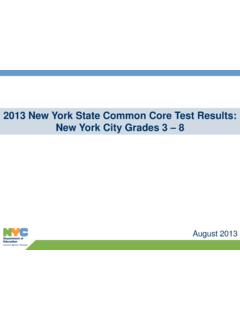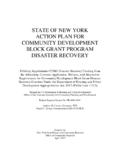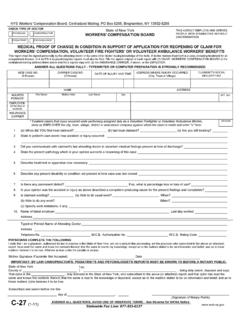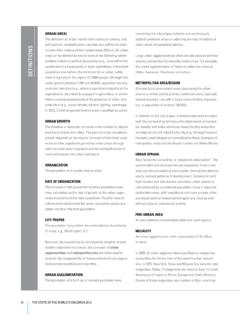Transcription of State of the SewerS 2012 - City of New York
1 Michael R. Bloomberg, MayorCarter H. Strickland, Jr., CommissionerState of the SewerS 2012 Friends,As New york city s water and wastewater utility, the Department of Environmental Protection (DEP) serves a vital purpose to the more than eight million New Yorkers: every day, DEP delivers more than one billion gallons of fresh drinking water and treats approximately billion gallons of wastewater. To carry out this mission, DEP has an extensive sewer maintenance, repair, and construction program that efficiently and effectively conveys wastewater from homes and businesses through 7,500 miles of SewerS to one of 14 wastewater treatment Strategy 2011-2014, we committed to operating the safest, most-effective, cost-efficient, and trans-parent water utility in the nation. To accomplish this goal, DEP uses advanced analytical tools and a risk management-based approach to target specific locations that are most problematic. We ve dedi-cated resources to examining not only how to fix a problem now, but also how to proactively target segments, blocks, and even entire neighborhoods to address the underlying conditions that lead to sewer backups.
2 Over the past year, we have begun a number of new initiatives that have had remark-able results: Confirmed sewer backups, a term used to describe high levels in the SewerS that sometimes result in actual backups in homes and businesses are down over last year; of catch basins are in a State of good repair; and 29 million pounds of debris have been removed from interceptor SewerS , increasing capacity by more than 100 million gallons , even with these promising trends, we know that there is more to be done. The analysis in this document not only explains programs already implemented, but also shares information on pilot pro-grams that will drive our field operations for years to come. I encourage you to read this document in conjunction with the NYC Green Infrastructure Plan: 2011 Update, Strategy 2011-2014: 2011 Progress Report, 2011 Best Management Practices Report, and 2011 Harbor Water Quality Report to get a full understanding of how DEP is working to position the city at the forefront of stormwater management and to create a greener, greater New ,Carter H.
3 Strickland, of ContentSIntroduCtIon ..5new york city sewer SYStem ..6 Street SweepIng and CatCh baSInS ..7 Catch Basin Inspection, Cleaning, and Repair ..8 ServICe lIneS and sewer ConneCtIonS ..9 Service Line Protection ..9 sewer maInS ..10 Fats, Oils, and Grease ..11 Biological Degreasers ..11 sewer Inspection, Analysis, and Analysis ..13 sewer Operations and Analysis Program Maps ..14 Standard Operating Procedures ..14 Tools of the Trade: sewer Inspection ..15 sewer Analysis Software ..15 sewer Maintenance ..16 Training Facility ..16 Manhole Sensors ..17 Extraordinary Storms ..18 sewer Repair and Construction ..19 Safety in the Streets ..19 Staten Island Bluebelt ..20 High Level Storm SewerS ..20 InterCeptor SewerS ..21 Interceptor Cleaning ..21performanCe metrICS ..22 Industry Benchmarks ..22 Citywide ..23 Bronx ..24 Brooklyn ..25 Manhattan ..26 Queens ..27 Staten Island ..28 ConCluSIon ..294 New york city s first sewer was a primitive open canal on Broad Street in lower Manhattan.
4 It was not until the mid-1800s when public health officials estab-lished a link between contact with untreated waste and cholera outbreaks that the city began plans to construct a citywide sewer system. Before then, it was common for residents to throw the contents of bedpans and washbasins directly out the window and for rotting trash and dead animals to sit on the streets for days. To prevent future cholera epidemics, the city began to construct underground SewerS to carry wastewa-ter from homes and businesses and to drain storm-water from increasingly dense city neighborhoods directly into New york Harbor. Because large swaths of the system were built prior to the consolidation of the five boroughs in 1898, there were no standard-ized designs or coordinated construction widespread adoption of indoor plumbing around the turn of the century meant that per capita generation of wastewater tracked, and ultimately surpassed, the rate of population growth in the the amount of wastewater the city generated in-creased, local waterways became severely oxygen deficient and highly polluted.
5 The resulting odors, closure of commercial shellfish beds, and outbreaks of waterborne diseases led to public support of wastewater treatment plants that would remove many of the harmful pathogens from the wastewa-ter before releasing it into local waterways. By the early 1900s, the city had constructed its first three wastewater treatment plants that relied on screening and sedimentation to remove solids, and on chlorine to disinfect the wastewater flow. To these steps of primary treatment, the city later added secondary treatment in the form of activated sludge or biological units, in which helpful bacteria eat and remove harmful pathogens. To carry waste-water to these new treatment plants, the city built large capacity SewerS , called interceptors, to inter-cept direct discharge points and carry wastewater to new facilities for treatment. In low-lying areas, the city built pump stations to lift the wastewater to a higher elevation so it could continue its journey by gravity to the treatment plants.
6 As the population grew and spread throughout the five boroughs, the city expanded the sewer system to encourage proper drainage and carry wastewater to the treatment plants. To manage the increased wastewater flow from new development, the city upgraded the three original plants and built eleven additional plants by 1987. Today, an average of billion gallons of waste-water per day travel through 7,500 miles of SewerS to 14 in- city wastewater treatment plants. To oper-ate and maintain the many components of this ex-tensive system, the New york city Department of Environmental Protection (DEP) has five repair yards, seven sewer maintenance yards, a fleet of special-ized vehicles, and a staff of laborers, supervisors, engineers, and analysts. In the last decade, DEP has shifted from a reactive approach to a data-driven, proactive approach to operate and maintain the sewer system. By using a range of digital tools and innovative practices, we can manage risk and pro-vide a high level of service to our customers while focusing investment to maximize the use of limited resources.
7 This report will describe these innovative tools and strategies and demonstrate how the city uses them to operate the sewer system better and more effectively than ever the early 1900s, SewerS were being built across the five boroughs, including the one above, in Manhattan in courtesy of the NYC Municipal TYPESEPARATECOMBINEDOTHERBLUEBELTnew york city sewer SYStem Approximately 60% of new york city s sewer system is com-bined, meaning that it handles sanitary waste from homes and businesses as well as stormwater from streets and roof-tops. This system includes more than 3,330 miles of SewerS throughout the five boroughs. Separate SewerS make up the other 40% of the sewer sys-tem. In a separate system, sanitary SewerS carry wastewater straight to the treatment plant, while storm SewerS carry stormwater runoff in a separate pipe directly to a local water-way. The separated sewer system in New york city includes 2,220 miles of sanitary SewerS and 1,820 miles of storm sew-ers.
8 The city also has 138 miles of interceptor SewerS which carry both stormwater and wastewater to treatment parts of the city do not have sanitary or combined SewerS . Generally, these neighborhoods developed before the sewer system could be extended to reach them, and therefore have suburban-style septic systems that treat wastewater on-site. Recently DEP brought municipal SewerS to Meadowmere in Queens, and continues to expand the sanitary and storm sewer net-work on the South Shore of Staten Island. 6 More than a quarter of new york city s land area con-sists of impervious streets and sidewalks. Most rain that falls on these surfaces ultimately find its way to our sewer system, generating significant amounts of runoff. Just one-inch of rain citywide generates approximately billion gallons of stormwater enough to fill the Empire State Building 19 times. Since the days of the Romans, roads have been designed with a high point in the center, called a crown, to channel water to the curb line.
9 From there, stormwater flows down the curb, collecting dust, lit-ter, and leaves along its way to the corner, where it falls into one of 148,000 catch catch basin is a type of storm drain covered by a heavy metal grate to prevent large objects from fall-ing in, and with a deep sump or storage container to collect dust, dirt, and other debris that runs off the street. A metal hood keeps lightweight objects like soda bottles and plastic bags from flowing into the sewer and helps mitigate unpleasant basins perform a complex and critical role for the city . Not only do they collect thousands of gallons of stormwater each year, they also must hold the weight of cars parking and driving on their grates and handle the leaves and trash that flow in from the street. DEP cleans tens of thousands of catch basins a year and repairs basins and grates af-fected by heavy vehicular traffic.
10 Excessive litter and debris can mat over the grate, causing water to bypass a catch basin. To prevent this, the Department of Sanitation clears debris from streets before it can cause problems, one of the rea-sons the city has alternate side parking to allow for street sweeping. When catch basins do not work properly, stormwater can back up onto the street and can cause flooding. New Yorkers can help pre-vent localized flooding by sweeping debris, includ-ing leaves and trash, into trash cans or by calling 311 to report a clogged catch SweepIng and CatCh baSInSHoodDebrisFloatablesCatch Basin GrateSewerConnectionCurb Piece7 DEP keeps a close eye on our catch basins to make sure they perform properly during storms. Our crews inspect all 148,000 catch basins every three years and clean them out as necessary. In the last year, we inspected more than 45,450 basins and cleaned out more than 20,050 of those that needed cleaning.

















